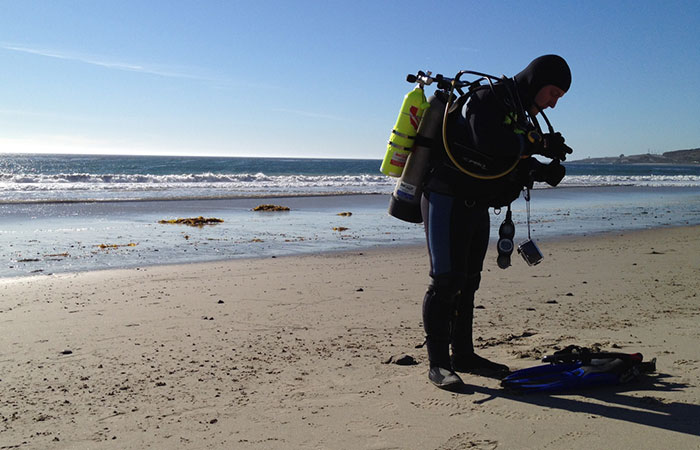
We are talking about the small scuba diving cylinder that divers carry as an extension to the scuba set for newbie divers. The pony bottle is used during an emergency underwater, such as a shortage of the diver’s main supply of breathing gas. So named “pony” due to its small size, pony bottles are often about just a few liters/cubic feet capacities.
Divers typically dive with a buddy, but one’s buddy is not necessarily going to be nearby all the time. A diver will be diving with strangers now and then, so carrying a pony bottle will likely help eliminate the risk of not having air at depth. A pony bottle will provide a little more confidence that if a diver is careful to follow accepted procedures, they are less likely to have a fatal issue while scuba diving.
Importance of Pony Bottle
In a high-stress situation, at a deeper depth, you would quickly suck a pony bottle down. If you suffer an equipment failure or run out of air at the center, or your diving buddy does, you’ll be exceeding any acceptable ascent rate. But to have enough air to reach the surface safely, you have to carry a pony bottle with a reasonably big capacity.
Pony bottles provide a fully independent and redundant source of air for the diver. Their cylinder capacity will depend on the profile for the safe ascent to the surface needed for your dive plan.
Pony bottles are available in various sizes, but the USA’s popular ones are 6, 13, and 19 cu ft, while in Europe, the 2-liter and 3-liter sizes are more common. Mostly, thirty cu ft (5 liters) and 40 cu ft (7 liters) cylinders are for wreck diving or deep technical diving.
Maybe you are interested : Wetsuit for fat guys? Guide and Tips
Maybe you are interested : Where are hog Regulators made?
Pony bottles may be purchased with the valve/regulator combo, and some also come with a mouthpiece.
Pony Bottle Sizes to Carry
Perhaps the most beneficial overall size for a pony bottle is 19 cu ft. Some divers say that anything smaller than a 13-cu ft bottle is not worth carrying, and anything bigger than a 19 is for extended diving. Others claim that pony bottle size for recreational diving can still be manageable from 20 to 30 cu ft. Either way, a pony bottle should be more than enough as an escape and give you time to figure things out.
Pony bottle gas consumption versus dive depths should consider when choosing the size as well. But remember, there is no such thing as too much air!
The Best Position to Carry a Pony Bottle
It’s your choice. Pony bottles can be clamped or strapped to your main tank or slung at your side. You may try both methods and see what works better for you.
Another way to carry the pony bottle is to mount it in a small carrying bag easily removed. It enables the diver to easily “hand-off” the entire system to a buddy diver if that buddy needs to share breathing gas. It is safer than having to be connected with the buddy through hosed regulators.
Traveling with Your Pony Bottle
Can you take your pony bottle on the airplane? The answer is yes.
If you’re traveling with a pony bottle, it must be empty and disassembled as per airline and TSA regulations. You will need to get your bottle filled at your destination.
Other Things to Consider
Most of the cost of a pony bottle is in the valve and regulator. Tank size doesn’t change the price significantly. The weight difference is also not quite different between a 13 cu ft, 19 cu ft, or even a 30 or a 40.
Divers should also analyze their breathing rates, the cylinder pressure to be used, and the required ascent profile.
Please note that a submersible pressure gauge is needed on the pony bottle regulator to monitor the pressure when in use. It will ensure that the diver surfaces before the gas runs out.
During the pre-dive buddy check, one must pay attention to where the pony bottle second stage regulator is placed. Take time to practice switching.
Final Thoughts
Hearing or reading about scuba accidents will make one conclude that the most likely way to die is due to a problem with one’s supply of breathing gas. Every diver should realize that no matter their planning and preparation, accidents may still happen. One cannot depend merely on a fellow diver for an emergency air supply.
In emergencies, a pony bottle can be used as a bailout bottle or a substitute air source to allow an average ascent instead of a controlled emergency swimming ascent.
Unless you’re diving shallowly, you need a significantly sized pony bottle. A bottle’s capacity and contents should be enough for a diver’s safe ascent from any point in the thought-out dive profile.
Again, bear in mind that there is no such thing as too much air. And there is nothing wrong with more extra redundancy duplicate stuff, the additional air that can save the day!
